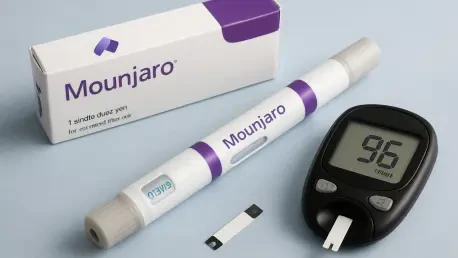I’m thrilled to sit down with Ivan Kairatov, a renowned biopharma expert with a wealth of experience in research and development, particularly in the realm of innovative technologies shaping the industry. Today, we’ll dive into the exciting world of diabetes and cardiovascular health treatments, focusing on the recent findings surrounding Mounjaro, a groundbreaking drug by Lilly. Our conversation will explore how this medication stands out in treating Type 2 diabetes, the significance of large-scale studies on its impact on heart health, and what the results mean for patients and doctors. We’ll also touch on broader implications for future research and patient care in this rapidly evolving field.
Can you give us a brief rundown of what Mounjaro is and how it plays a role in managing Type 2 diabetes?
Absolutely, I’m happy to break it down. Mounjaro is a relatively new medication developed by Lilly for treating Type 2 diabetes. Its active ingredient, tirzepatide, works by targeting two key hormone receptors, GLP-1 and GIP, which help regulate blood sugar levels and appetite. This dual action sets it apart and makes it quite effective not just for controlling diabetes but also for aiding weight loss, which is often a significant concern for patients. It’s typically administered as a weekly injection, and it’s quickly gained traction as a go-to option for many due to its promising results.
How does Mounjaro’s mechanism differ from other diabetes medications, such as Trulicity, in terms of its impact on the body?
That’s a great question. While both Mounjaro and Trulicity target the GLP-1 receptor to improve blood sugar control and promote weight loss, Mounjaro goes a step further by also activating the GIP receptor. This additional pathway seems to enhance its effects, particularly on insulin secretion and fat metabolism. In practical terms, this often translates to greater weight reduction and sometimes better blood sugar management compared to Trulicity, which relies solely on GLP-1 stimulation. It’s this dual mechanism that has sparked a lot of interest in the medical community.
The Surpass-CVOT study, which included over 13,000 participants, is a major milestone. Why do you think such a large and long-term trial was critical for understanding Mounjaro’s potential?
Large-scale, long-term studies like Surpass-CVOT are essential because they give us a clearer picture of a drug’s real-world impact, especially for chronic conditions like diabetes that often come with related complications such as heart disease. With over 13,000 participants and nearly five years of data, this trial provides robust evidence on how Mounjaro performs over time, not just in controlled settings but across diverse patient groups. It’s about building trust—showing that the benefits hold up under scrutiny and that any risks are well understood. For a drug like Mounjaro, which is already popular, this kind of study is key to solidifying its place in treatment guidelines.
What were the primary objectives Lilly aimed to achieve with this extensive five-year trial?
Lilly’s main goal with Surpass-CVOT was to evaluate Mounjaro’s effectiveness in protecting heart health in patients with Type 2 diabetes and existing heart disease, using a specific measure called MACE-3, which tracks major cardiovascular events like heart attacks, strokes, or related deaths. They wanted to see if Mounjaro could match or even outperform Trulicity, an established drug, on this critical endpoint. Beyond that, the trial also looked at secondary benefits, such as improvements in blood sugar control, kidney function, and weight loss, to build a comprehensive profile of the drug’s impact on overall health.
The trial results indicated Mounjaro was roughly as effective as Trulicity in protecting heart health. How do you think this shapes the decision-making process for patients and doctors when choosing between these two options?
It’s an interesting outcome. Showing that Mounjaro is on par with Trulicity in terms of heart health protection is actually a win, as Trulicity has a well-established track record. For doctors and patients, this means Mounjaro is a reliable alternative, especially since it offers additional benefits like greater weight loss and potentially better blood sugar control. The choice might come down to individual patient needs—someone struggling more with weight might lean toward Mounjaro, while others might stick with Trulicity due to familiarity or cost considerations. It broadens the toolkit for personalized care, which is always a positive.
One standout finding was a 16% lower rate of all-cause mortality with Mounjaro compared to Trulicity. Can you explain in simple terms what ‘all-cause mortality’ means and why this matters?
Sure, ‘all-cause mortality’ simply refers to death from any reason, not just a specific condition like heart disease. So, a 16% lower rate means that, overall, fewer people taking Mounjaro passed away during the study period compared to those on Trulicity, regardless of the cause. This is significant because it suggests Mounjaro might have broader protective effects on health beyond just managing diabetes or heart issues. It’s a signal that the drug could be improving overall well-being, which is a big deal for patients living with chronic conditions and for doctors looking at long-term outcomes.
Beyond the heart health comparison, were there other benefits like weight loss or blood sugar management where Mounjaro really shone in the study?
Absolutely, Mounjaro showed some impressive secondary benefits in the Surpass-CVOT trial. Participants on Mounjaro lost significantly more weight—on average about 25 pounds over three years compared to around 10 pounds with Trulicity. That’s a substantial difference for many patients with Type 2 diabetes, where weight management is often a key part of treatment. Additionally, there were notable improvements in blood sugar control and even kidney function, which are critical for long-term health in this population. These added advantages make Mounjaro a compelling option, even if the primary heart health endpoint didn’t show superiority.
Lilly also made an indirect comparison to an older study, estimating Mounjaro reduces heart risk by 28% compared to a placebo. How much weight do you think we should give to these kinds of indirect comparisons?
Indirect comparisons can be useful, but they come with caveats. What Lilly did was match data from the Surpass-CVOT trial with an earlier study on Trulicity versus a placebo to estimate Mounjaro’s potential benefit. A 28% risk reduction for heart events sounds promising, but since it’s not a direct head-to-head comparison with a placebo in the same study, there are variables—like differences in patient groups or study conditions—that can skew the interpretation. It’s a helpful starting point to gauge a drug’s potential, but I’d say we need more direct evidence to fully trust these numbers. They’re more of a hypothesis generator for future research.
Looking ahead, what’s your forecast for the future of treatments like Mounjaro in managing both diabetes and related conditions like heart disease?
I’m very optimistic about the trajectory of treatments like Mounjaro. We’re seeing a shift in biopharma toward drugs that don’t just tackle one issue but address multiple aspects of health—diabetes, weight, heart risk, and even beyond. Mounjaro’s dual mechanism is a prime example of this trend, and I expect we’ll see more innovation in this space, with therapies becoming even more targeted and personalized. Additionally, as studies continue to explore broader benefits, like reducing overall mortality or improving kidney health, I think insurance coverage and prescribing patterns will evolve to favor these multi-benefit drugs. The next decade could redefine how we manage chronic diseases, with an emphasis on holistic outcomes.









